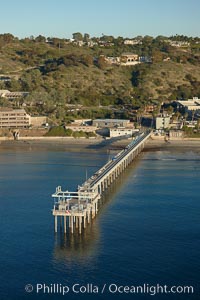
SIO Pier, Scripps Pier, La Jolla. The Scripps Institution of Oceanography research pier is 1090 feet long and was built of reinforced concrete in 1988, replacing the original wooden pier built in 1915. The Scripps Pier is home to a variety of sensing equipment above and below water that collects various oceanographic data. The Scripps research diving facility is located at the foot of the pier. Fresh seawater is pumped from the pier to the many tanks and facilities of SIO, including the Birch Aquarium. The Scripps Pier is named in honor of Ellen Browning Scripps, the most significant donor and benefactor of the Institution.
Location: Scripps Institution of Oceanography, La Jolla, California
Image ID: 22286
Location: Scripps Institution of Oceanography, La Jolla, California
Image ID: 22286
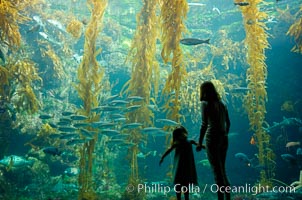
A parent and child admire the fascinating kelp forest tank at the Birch Aquarium at Scripps Institution of Oceanography, San Diego, California.
Species: Giant kelp, Macrocystis pyrifera
Image ID: 10308
Species: Giant kelp, Macrocystis pyrifera
Image ID: 10308
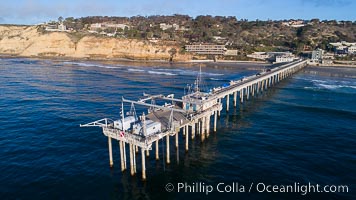
Aerial Photo of Scripps Pier. SIO Pier. The Scripps Institution of Oceanography research pier is 1090 feet long and was built of reinforced concrete in 1988, replacing the original wooden pier built in 1915. The Scripps Pier is home to a variety of sensing equipment above and below water that collects various oceanographic data. The Scripps research diving facility is located at the foot of the pier. Fresh seawater is pumped from the pier to the many tanks and facilities of SIO, including the Birch Aquarium. The Scripps Pier is named in honor of Ellen Browning Scripps, the most significant donor and benefactor of the Institution.
Location: Scripps Institution of Oceanography, La Jolla, California
Image ID: 38231
Location: Scripps Institution of Oceanography, La Jolla, California
Image ID: 38231
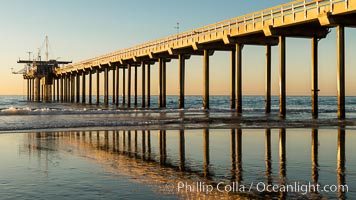
SIO Pier. The Scripps Institution of Oceanography research pier is 1090 feet long and was built of reinforced concrete in 1988, replacing the original wooden pier built in 1915. The Scripps Pier is home to a variety of sensing equipment above and below water that collects various oceanographic data. The Scripps research diving facility is located at the foot of the pier. Fresh seawater is pumped from the pier to the many tanks and facilities of SIO, including the Birch Aquarium. The Scripps Pier is named in honor of Ellen Browning Scripps, the most significant donor and benefactor of the Institution.
Location: Scripps Institution of Oceanography, La Jolla, California
Image ID: 36558
Location: Scripps Institution of Oceanography, La Jolla, California
Image ID: 36558
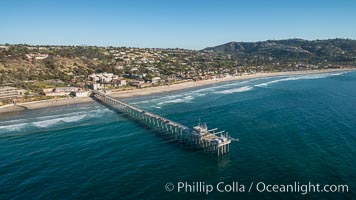
Aerial Photo of Scripps Pier. SIO Pier. The Scripps Institution of Oceanography research pier is 1090 feet long and was built of reinforced concrete in 1988, replacing the original wooden pier built in 1915. The Scripps Pier is home to a variety of sensing equipment above and below water that collects various oceanographic data. The Scripps research diving facility is located at the foot of the pier. Fresh seawater is pumped from the pier to the many tanks and facilities of SIO, including the Birch Aquarium. The Scripps Pier is named in honor of Ellen Browning Scripps, the most significant donor and benefactor of the Institution.
Image ID: 30737
Image ID: 30737
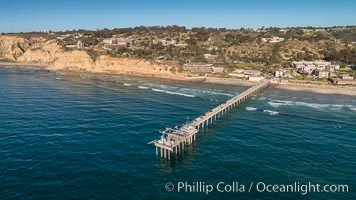
Aerial Photo of Scripps Pier. SIO Pier. The Scripps Institution of Oceanography research pier is 1090 feet long and was built of reinforced concrete in 1988, replacing the original wooden pier built in 1915. The Scripps Pier is home to a variety of sensing equipment above and below water that collects various oceanographic data. The Scripps research diving facility is located at the foot of the pier. Fresh seawater is pumped from the pier to the many tanks and facilities of SIO, including the Birch Aquarium. The Scripps Pier is named in honor of Ellen Browning Scripps, the most significant donor and benefactor of the Institution.
Image ID: 30738
Image ID: 30738
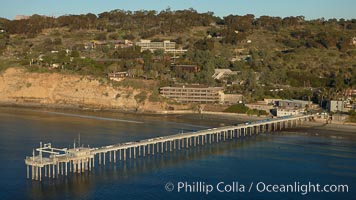
SIO Pier. The Scripps Institution of Oceanography research pier is 1090 feet long and was built of reinforced concrete in 1988, replacing the original wooden pier built in 1915. The Scripps Pier is home to a variety of sensing equipment above and below water that collects various oceanographic data. The Scripps research diving facility is located at the foot of the pier. Fresh seawater is pumped from the pier to the many tanks and facilities of SIO, including the Birch Aquarium. The Scripps Pier is named in honor of Ellen Browning Scripps, the most significant donor and benefactor of the Institution.
Location: Scripps Institution of Oceanography, La Jolla, California
Image ID: 22293
Location: Scripps Institution of Oceanography, La Jolla, California
Image ID: 22293
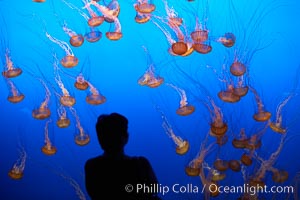
Visitors enjoy viewing sea nettle jellyfish at the Monterey Bay Aquarium.
Species: Sea nettles, Chrysaora fuscescens
Location: Monterey, California
Image ID: 21539
Species: Sea nettles, Chrysaora fuscescens
Location: Monterey, California
Image ID: 21539
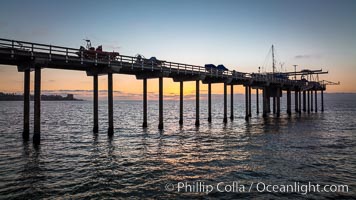
SIO Pier. The Scripps Institution of Oceanography research pier is 1090 feet long and was built of reinforced concrete in 1988, replacing the original wooden pier built in 1915. The Scripps Pier is home to a variety of sensing equipment above and below water that collects various oceanographic data. The Scripps research diving facility is located at the foot of the pier. Fresh seawater is pumped from the pier to the many tanks and facilities of SIO, including the Birch Aquarium. The Scripps Pier is named in honor of Ellen Browning Scripps, the most significant donor and benefactor of the Institution.
Location: Scripps Institution of Oceanography, La Jolla, California
Image ID: 38023
Location: Scripps Institution of Oceanography, La Jolla, California
Image ID: 38023
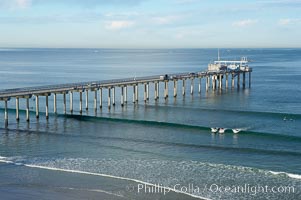
The Scripps Institution of Oceanography research pier is 1090 feet long and was built of reinforced concrete in 1988, replacing the original wooden pier built in 1915. The Scripps Pier is home to a variety of sensing equipment above and below water that collects various oceanographic data. The Scripps research diving facility is located at the foot of the pier. Fresh seawater is pumped from the pier to the many tanks and facilities of SIO, including the Birch Aquarium. The Scripps Pier is named in honor of Ellen Browning Scripps, the most significant donor and benefactor of the Institution.
Location: Scripps Institution of Oceanography, La Jolla, California
Image ID: 14748
Location: Scripps Institution of Oceanography, La Jolla, California
Image ID: 14748
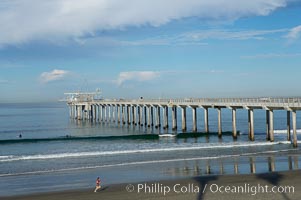
The Scripps Institution of Oceanography research pier is 1090 feet long and was built of reinforced concrete in 1988, replacing the original wooden pier built in 1915. The Scripps Pier is home to a variety of sensing equipment above and below water that collects various oceanographic data. The Scripps research diving facility is located at the foot of the pier. Fresh seawater is pumped from the pier to the many tanks and facilities of SIO, including the Birch Aquarium. The Scripps Pier is named in honor of Ellen Browning Scripps, the most significant donor and benefactor of the Institution.
Location: Scripps Institution of Oceanography, La Jolla, California
Image ID: 14749
Location: Scripps Institution of Oceanography, La Jolla, California
Image ID: 14749
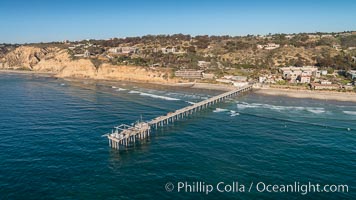
Aerial Photo of Scripps Pier. SIO Pier. The Scripps Institution of Oceanography research pier is 1090 feet long and was built of reinforced concrete in 1988, replacing the original wooden pier built in 1915. The Scripps Pier is home to a variety of sensing equipment above and below water that collects various oceanographic data. The Scripps research diving facility is located at the foot of the pier. Fresh seawater is pumped from the pier to the many tanks and facilities of SIO, including the Birch Aquarium. The Scripps Pier is named in honor of Ellen Browning Scripps, the most significant donor and benefactor of the Institution.
Image ID: 30739
Image ID: 30739
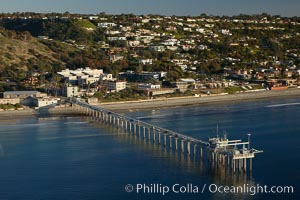
SIO Pier. The Scripps Institution of Oceanography research pier is 1090 feet long and was built of reinforced concrete in 1988, replacing the original wooden pier built in 1915. The Scripps Pier is home to a variety of sensing equipment above and below water that collects various oceanographic data. The Scripps research diving facility is located at the foot of the pier. Fresh seawater is pumped from the pier to the many tanks and facilities of SIO, including the Birch Aquarium. The Scripps Pier is named in honor of Ellen Browning Scripps, the most significant donor and benefactor of the Institution.
Location: Scripps Institution of Oceanography, La Jolla, California
Image ID: 22313
Location: Scripps Institution of Oceanography, La Jolla, California
Image ID: 22313
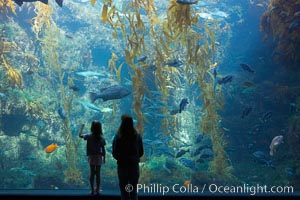
Visitors admire the enormous kelp forest tank in the Stephen Birch Aquarium at the Scripps Institution of Oceanography. The 70000 gallon tank is home to black seabass, broomtail grouper, garibaldi, moray eels and leopard sharks.
Location: Stephen Birch Aquarium, La Jolla, California
Image ID: 14546
Location: Stephen Birch Aquarium, La Jolla, California
Image ID: 14546
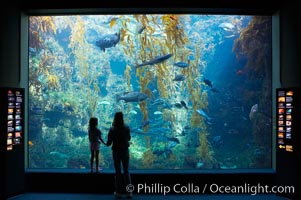
Visitors admire the enormous kelp forest tank in the Stephen Birch Aquarium at the Scripps Institution of Oceanography. The 70000 gallon tank is home to black seabass, broomtail grouper, garibaldi, moray eels and leopard sharks.
Location: Stephen Birch Aquarium, La Jolla, California
Image ID: 14547
Location: Stephen Birch Aquarium, La Jolla, California
Image ID: 14547
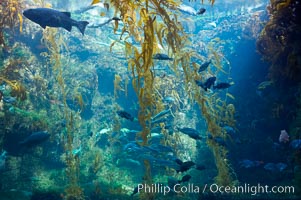
The kelp forest tank in the Stephen Birch Aquarium at the Scripps Institution of Oceanography. The 70000 gallon tank is home to black seabass, broomtail grouper, garibaldi, moray eels and leopard sharks.
Location: Stephen Birch Aquarium, La Jolla, California
Image ID: 14548
Location: Stephen Birch Aquarium, La Jolla, California
Image ID: 14548
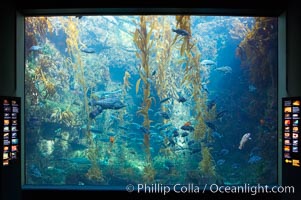
The kelp forest tank in the Stephen Birch Aquarium at the Scripps Institution of Oceanography. The 70000 gallon tank is home to black seabass, broomtail grouper, garibaldi, moray eels and leopard sharks.
Location: Stephen Birch Aquarium, La Jolla, California
Image ID: 14549
Location: Stephen Birch Aquarium, La Jolla, California
Image ID: 14549
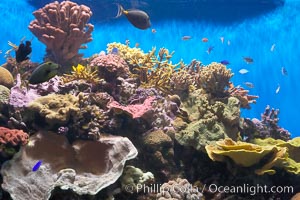
A tropical reef fish tank in the Stephen Birch Aquarium at the Scripps Institution of Oceanography. Built in 1992, the Birch Aquarium has over 60 tanks including a 70000 gallon kelp forest tank and 13000 gallon shark exhibit.
Location: Stephen Birch Aquarium, La Jolla, California
Image ID: 14550
Location: Stephen Birch Aquarium, La Jolla, California
Image ID: 14550
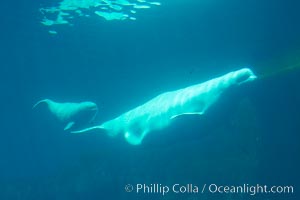
Beluga whale mother and calf.
Location: Vancouver Aquarium, British Columbia, Canada
Image ID: 21171
Location: Vancouver Aquarium, British Columbia, Canada
Image ID: 21171
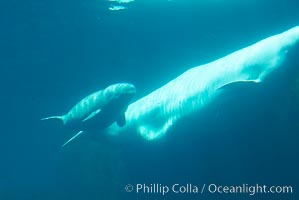
Beluga whale mother and calf.
Location: Vancouver Aquarium, British Columbia, Canada
Image ID: 21172
Location: Vancouver Aquarium, British Columbia, Canada
Image ID: 21172
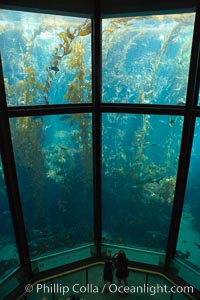
Giant kelp forest tank, Monterey Bay Aquarium.
Image ID: 21537
Image ID: 21537
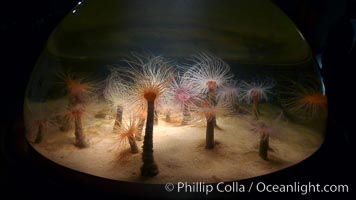
Tube anemones in a clear globe display at the Monterey Bay Aquarium.
Species: Tube anemone, Pachycerianthus fimbriatus
Location: Monterey, California
Image ID: 21500
Species: Tube anemone, Pachycerianthus fimbriatus
Location: Monterey, California
Image ID: 21500
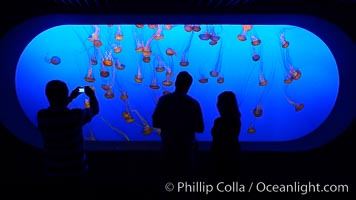
Visitors enjoy viewing sea nettle jellyfish at the Monterey Bay Aquarium.
Species: Sea nettles, Chrysaora fuscescens
Location: Monterey, California
Image ID: 21501
Species: Sea nettles, Chrysaora fuscescens
Location: Monterey, California
Image ID: 21501
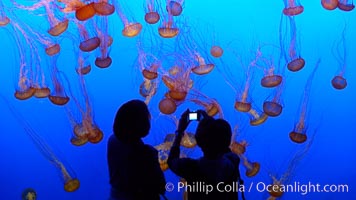
Visitors enjoy viewing sea nettle jellyfish at the Monterey Bay Aquarium.
Species: Sea nettles, Chrysaora fuscescens
Location: Monterey, California
Image ID: 21502
Species: Sea nettles, Chrysaora fuscescens
Location: Monterey, California
Image ID: 21502
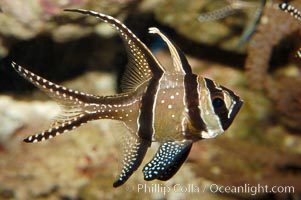
Banggai Cardinalfish. Once thought to be found at Banggai Island near Sulawesi, Indonesia, it has recently been found at Lembeh Strait and elsewhere. The male incubates the egg mass in his mouth, then shelters a brood of 10-15 babies in his mouth after they hatch, the only fish known to exhibit this behaviour. Unfortunately, the aquarium trade is threatening the survival of this species in the wild.
Species: Banggai cardinalfish, Pterapogon kauderni
Image ID: 08900
Species: Banggai cardinalfish, Pterapogon kauderni
Image ID: 08900
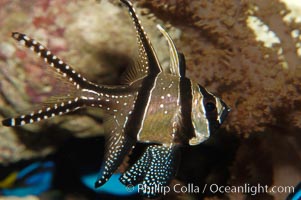
Banggai Cardinalfish. Once thought to be found at Banggai Island near Sulawesi, Indonesia, it has recently been found at Lembeh Strait and elsewhere. The male incubates the egg mass in his mouth, then shelters a brood of 10-15 babies in his mouth after they hatch, the only fish known to exhibit this behaviour. Unfortunately, the aquarium trade is threatening the survival of this species in the wild.
Species: Banggai cardinalfish, Pterapogon kauderni
Image ID: 08901
Species: Banggai cardinalfish, Pterapogon kauderni
Image ID: 08901
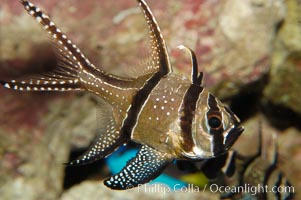
Banggai Cardinalfish. Once thought to be found at Banggai Island near Sulawesi, Indonesia, it has recently been found at Lembeh Strait and elsewhere. The male incubates the egg mass in his mouth, then shelters a brood of 10-15 babies in his mouth after they hatch, the only fish known to exhibit this behaviour. Unfortunately, the aquarium trade is threatening the survival of this species in the wild.
Species: Banggai cardinalfish, Pterapogon kauderni
Image ID: 08902
Species: Banggai cardinalfish, Pterapogon kauderni
Image ID: 08902
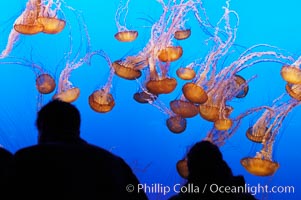
Visitors watch a graceful, slow moving group of sea nettle jellyfishes at the Monterey Bay Aquarium.
Species: Sea nettles, Chrysaora fuscescens
Location: Monterey, California
Image ID: 08966
Species: Sea nettles, Chrysaora fuscescens
Location: Monterey, California
Image ID: 08966
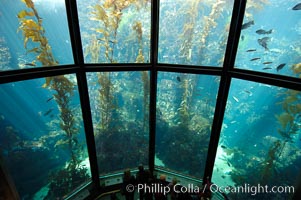
Visitors enjoy the enormous kelp forest tank at the Monterey Bay Aquarium.
Location: Monterey, California
Image ID: 09069
Location: Monterey, California
Image ID: 09069
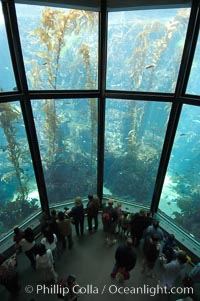
Visitors enjoy the enormous kelp forest tank at the Monterey Bay Aquarium.
Location: Monterey, California
Image ID: 09070
Location: Monterey, California
Image ID: 09070